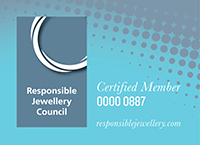What Is a True Buying Signal?
"I'm 99% certain that it's sold!"
That comment is heard daily by our account reps. Often times, it ends up as a sale. However, sometimes it doesn't. So what happened? The most common scenario is that the retailer truly believes that the diamond is sold. This is based on what he or she was communicated during the presentation and it is very understandable. As a salesperson, we often feel we did a great job of figuring out what the customer was looking for and presented them with the appropriate options. There`s a lot of head nodding in approval as we describe all the reasons why this is the perfect item for their particular needs.
"Sounds good. I`ll be back tomorrow to finish the deal!"
So it's 99% sold, right? Sound familiar? Well, it is not exactly a true buying signal. Let`s dig deeper. A customer that leaves your store without a firm commitment (deposit or more) is by definition uncommitted and not sold. That hesitation is preventing a favorable decision and must be addressed NOW! To create an opportunity to get a true buying signal, your customer must be fully engaged in the sales process. Head nodding isn`t enough. They need to speak! A sales pitch that becomes a monologue doesn`t allow your prospect to voice their concerns. What you feel is important may not be equivalent to what they are feeling. Without time to absorb, most of what you say will not be heard. Allow them time to absorb an important feature that they told you in the qualify. Their favorable reaction to the feature is a buying signal. A confused look or a question should indicate that it`s time to address the concern before you move forward.
 At this point, you have made the case of why the item you have pitched them is the correct item. This is based on what they feel is important. The opportunity to close the deal is never higher than it will be at this very moment. I can't stress this enough: nothing good will come from a delayed closing. An assumed close is a great way to finish the deal. You`ve hit all the features that they were interested in. It`s in the budget. And most of all, it is here now. In the case of an engagement diamond you're close could be "So what are we going to mount it in?" or "I`ll have it ready for you on Thursday."
Strong assumed closings require that you did your qualify correct, presented an appropriate item and addressed any concerns. If you think that a strong close is being "pushy", you are mistaken. If a customer stops you at this point then you missed something. There is something going on in your customer's head that is stopping them from making a decision. They may not articulate what that is if you do not probe deeper. When there's doubt or confusion they will not buy. They'll be polite and give you an excuse that sounds reasonable but that excuse will likely miss the mark. You need to dig deeper and get real answers.
One of the most difficult exercises a salesperson needs to master is to ask a question and actually WAIT for the answer. We hate dead time. We feel like it has to be filled. So if they`re not talking we have to. Typically, a question is asked and before the customer has a moment to think it over, we turn it to a multiple-choice question just to move it along. That is unlikely to get an accurate answer since you created the questions. Once again, this is based on what you already know. However, it`s not necessarily what your customer is contemplating. In worst cases, our volunteering of possible reasons not to buy may bring light to more reasons not to buy and cause even more doubt.
At this point, you have made the case of why the item you have pitched them is the correct item. This is based on what they feel is important. The opportunity to close the deal is never higher than it will be at this very moment. I can't stress this enough: nothing good will come from a delayed closing. An assumed close is a great way to finish the deal. You`ve hit all the features that they were interested in. It`s in the budget. And most of all, it is here now. In the case of an engagement diamond you're close could be "So what are we going to mount it in?" or "I`ll have it ready for you on Thursday."
Strong assumed closings require that you did your qualify correct, presented an appropriate item and addressed any concerns. If you think that a strong close is being "pushy", you are mistaken. If a customer stops you at this point then you missed something. There is something going on in your customer's head that is stopping them from making a decision. They may not articulate what that is if you do not probe deeper. When there's doubt or confusion they will not buy. They'll be polite and give you an excuse that sounds reasonable but that excuse will likely miss the mark. You need to dig deeper and get real answers.
One of the most difficult exercises a salesperson needs to master is to ask a question and actually WAIT for the answer. We hate dead time. We feel like it has to be filled. So if they`re not talking we have to. Typically, a question is asked and before the customer has a moment to think it over, we turn it to a multiple-choice question just to move it along. That is unlikely to get an accurate answer since you created the questions. Once again, this is based on what you already know. However, it`s not necessarily what your customer is contemplating. In worst cases, our volunteering of possible reasons not to buy may bring light to more reasons not to buy and cause even more doubt.

"Let me check my finances first."
"Sounds perfect!"
"It's a lot of money and I don't like making quick decisions."
"I just want to think about it."
"I want to talk it over with ... before I proceed."
Any of these are just excuses. They sound reasonable, and usually work because the goal of the consumer is trying to gracefully get out of your store WITHOUT making a purchase. Your prospect is uneasy about something. Don't guess. Ask! There is nothing wrong with asking your customer "I can sense that you're hesitant, what can I do to clarify things?" Now patiently wait. It will be uncomfortable. Seconds will seem like hours. Remember that you`ve asked a thought-provoking question. The customer may not be sure of why they`re hesitant. Asking good questions and patiently waiting for good answers will get you better results.

 By: Bob DeMaria
Bob DeMaria has 45 years experience in sales and marketing both as an inside and outside sales representative within RDI Diamonds and the wholesale jewelry industry. Bob welcomes any feedback or suggestions for future topics. He can be reached at 800-874-8768 ext. 110 or by email at bdemaria@rdidiamonds.com.
By: Bob DeMaria
Bob DeMaria has 45 years experience in sales and marketing both as an inside and outside sales representative within RDI Diamonds and the wholesale jewelry industry. Bob welcomes any feedback or suggestions for future topics. He can be reached at 800-874-8768 ext. 110 or by email at bdemaria@rdidiamonds.com.























